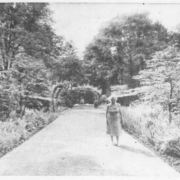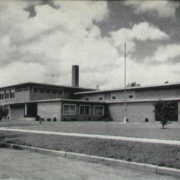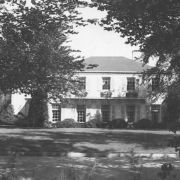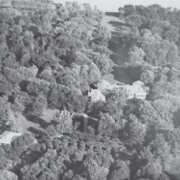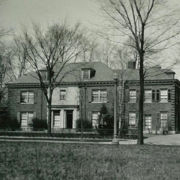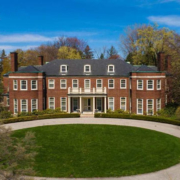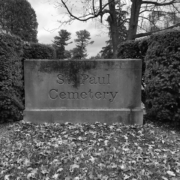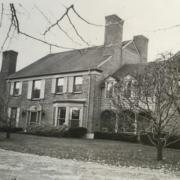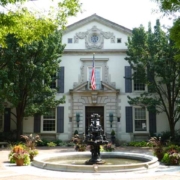Historical Architecture of Grosse Pointe – Garden Pilgrimage Tours
Last week we concluded our two-part series on John L. Pottle, one of Grosse Pointe’s most prolific architects. He designed a significant number of homes and several commercial buildings throughout the community during the 1940’s-1960’s.
This week, with summer drawing to a close, we would like to take the opportunity to present the history of the Detroit Garden Center’s Garden Pilgrimage Tour, an annual tour that began around 1935. Landscape design in Grosse Pointe has always been an important feature of many homes. Not only were nationally renowned landscape designers hired, but plants and decorative items were sourced from all over the world.
It is possible the event stemmed from a Garden Pilgrimage that was held in Grosse Pointe in the early 1930’s. During this period the pilgrimage was held at some of Grosse Pointe’s most spectacular gardens that were opened to the public on payment of a small fee. And of course, it wasn’t just the gardens on display, many of the women involved in making the event a success were prominent members of the community who lived in magnificent homes such as Mrs. Russell Alger; Mrs. Phelps Newberry; Mrs. Wesson Seyburn; and Mrs. Sidney Miller. Some of those involved also opened their houses to serve tea to guests. Image: Detroit Free Press (May 1935).
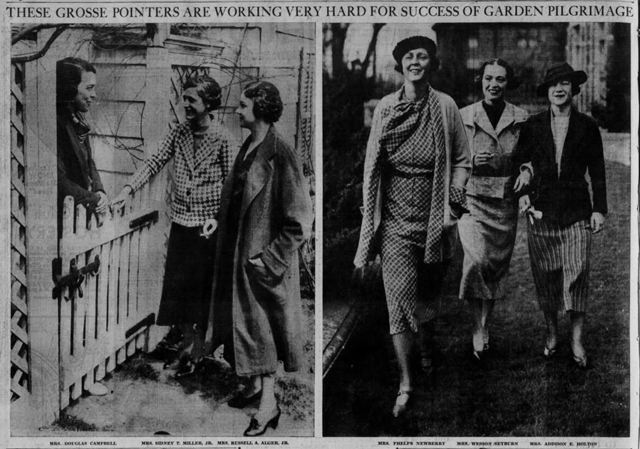
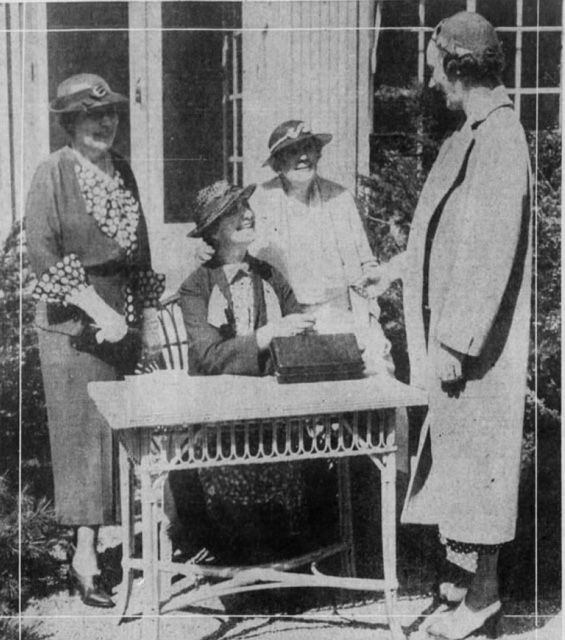
Around the mid 1930’s, it appears the tour was expanded by The Detroit Garden Center (founded in 1933) to create a larger-scale event to help support the free services offered by The Detroit Garden Center. The pilgrimages, that generally ran from Tuesday through Sunday, were then held annually except during the war. It was reported “a specified number of gardens in reasonable proximity were open on specified days, with hostesses on hand to answer questions. Each visitor followed their own schedule, vising gardens at their own convenience.” Visitors were asked to wear low heeled shoes. Source: Detroit Free Press (May 1935).
The tour featured large and small, formal and informal gardens. On display were exotic blooms, unique arrangements of commonplace plants, original settings, rock and vegetable gardens, terraced and woodland gardens, magnificent shrubs, pools, and bird sanctuaries. Some of the most superb gardens in the area were on viewable such as Rose Terrace, the Standish Backus Mansion at 725 Lake Shore, The Barbour mansion at 147 Lake Shore, The Kanzler estate at 241 lake Shore, and Alger House (the Grosse Pointe War Memorial). Many of these gardens were created by nationally renowned landscape architects including Ellen Biddle Shipman, William Pitkin Jr., Leonard B. Willeke, and Ruth Bramley Dean.
In the early years, the dates for the tour were selected when certain types of flowers were at their best. In 1939, iris time was chosen, and in 1940, it was tulip time. It was reported (in 1940) the 10 gardens on display (in Grosse Pointe) were selected during the fall of the previous year – “special tulip plantings were made in each garden so that the visitors, come spring, would see plantings of many different kinds. At the Torrey estate 5,600 new and unusual tulips were planted in a mass planting in front of the conservatories while the lovely spring garden of primroses and early smaller bulbs were ready to enjoy.” Source: The Grosse Pointe Review (May 16, 1940). In the Oscar Webber Garden (22 Webber Place) beautiful evergreens, pools and brooks, fine architectural features, along with tulips as the seasonal flower were on display. Another house had tulips in both the perennial gardens and in the old fruit orchard.
By 1948, 67 gardens were part of the tour. That year the proceeds were used to ensure the Detroit Garden Center would be able to continue to give horticultural advice to Detroiters, and to help beatify Detroit. A ticket cost $1.50 (around $20 today) and allowed the bearer to visit all the gardens on display. The gardens on tour were in Detroit, Dearborn, Highland Park, Royal Oak, Grosse Pointe, Huntington Woods, Birmingham, Bloomfield Hills, and Pleasant Ridge. Source: Detroit Free Press (June 1948). The tour featured the following gardens in Grosse Pointe:
437, 410, and 372 Lakeland; 147, 725, 936, and 655 Lake Shore; 125 Kenwood; 124 Merriweather; 235 and 286 Touraine; 43 Oldbrook Lane; 226 and 242 Provencal; 1005 Yorkshire; 17100 and 17620 E. Jefferson; 315 Washington.
Pictured below is part of the garden at 315 Washington, the home of Mrs. Ralph Booth. The imported statuary in the garden, noted throughout the Midwest, included the green and bronze dolphin (shown above). Source and image: Detroit Free Press (June 1948).
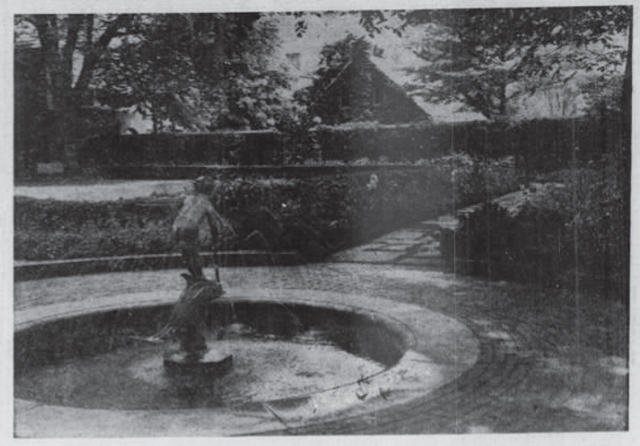
In 1949, 17 gardens in Grosse Pointe were part of the pilgrimage, including the garden of Mr. and Mrs. Barbour at 147 Lake Shore, with its “profusion of wisteria”. And the Mrs. Henry P. Williams Garden at 344 Provencal which had “a pretty grass walk, flanked by tulips and flowering shrubs. Images courtesy of: Detroit Free Press (May 1949).
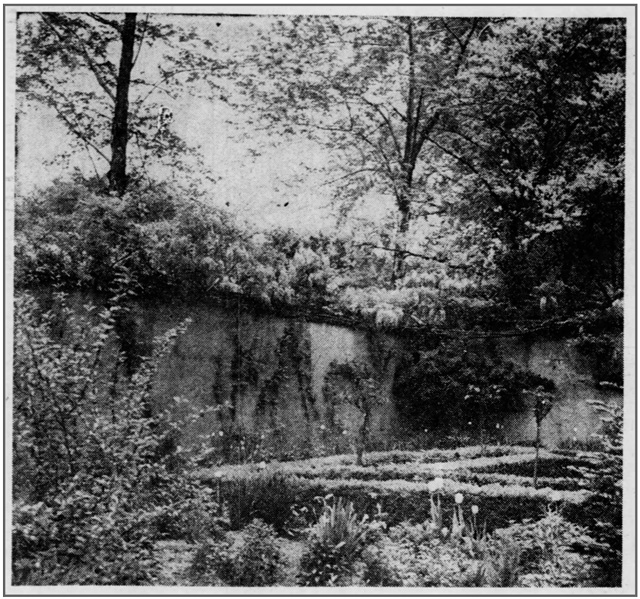
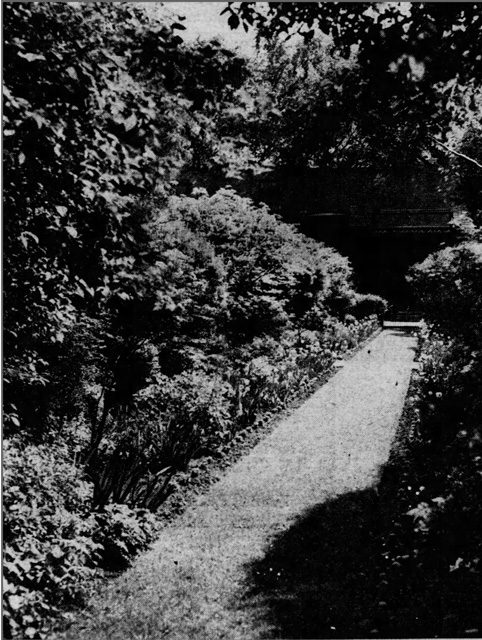
There were 10 gardens on show in Grosse Pointe for the event in June 1959, including 280 Vincennes, 515 Lake Shore; 735 Lake Shore; 268 Provencal; 242 Provencal; 193 Ridge; 147 Lake Shore, 635 Lake Shore; 40 Fairford; and 37 Edgemere. Special features of the gardens that year were reflecting pools, a statuary, a sunken garden, fountains, and terraces. The Mrs. Benjamin S. Warren Garden at 635 Lake Shore was described as “a mature garden with fine yews. The reflecting pool is a copy of the one in Alhambra, Spain, a wall is patterned after one in Sicily, the iron gate is from Seville, and a bird bath came from Italy.” Meanwhile the delightful garden of Mr. and Mrs. Joseph Vlasic at 40 Fairford featured a free form terrace and a small fountain. Source and images: Detroit Free Press (June 1959).
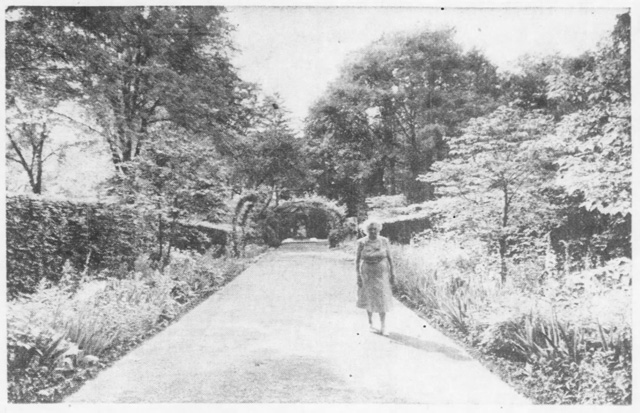
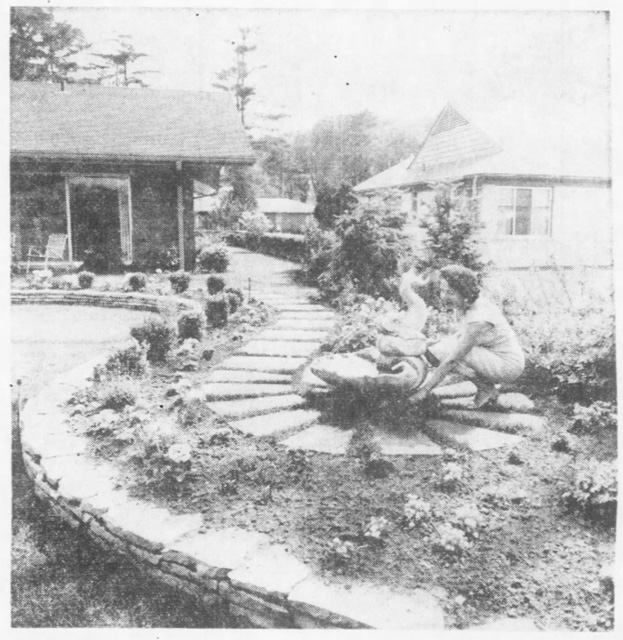
One of the highlights of the tour in 1961 was the Mr. and Mrs. Arthur Naman garden at 415 Lake Shore. The write up in the Detroit Free Press (June 1961) states “the garden was on two levels with a terrace of old stone and a circular wall on the upper terrace. Ground covers of different varieties and many trees, including 24 dogwood. While called a “Dogwood Garden” in spring, it was interesting at all times of the year. There is a big walled-in patio, with a small pool and garden sculpture. Old World Atmosphere.” Source and images: Detroit Free Press (June 1961).
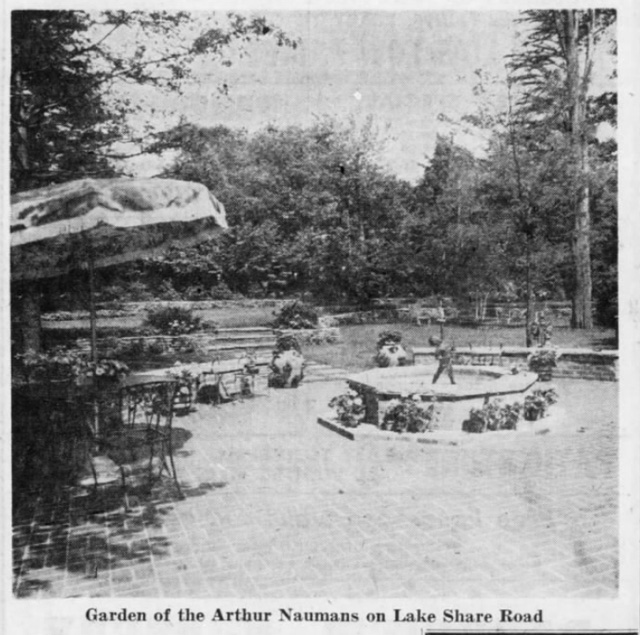
During the tour of 1962, the Mr. and Mrs. Frederick A. Kramer Garden at 38 Kerby welcomed visitors to enjoy “a handsome garden with a stone patio, a small formal pool and an outdoor fireplace. A greenhouse and a “Memory Garden” added atmosphere.” Source and image: Detroit Free Press (May 1962).
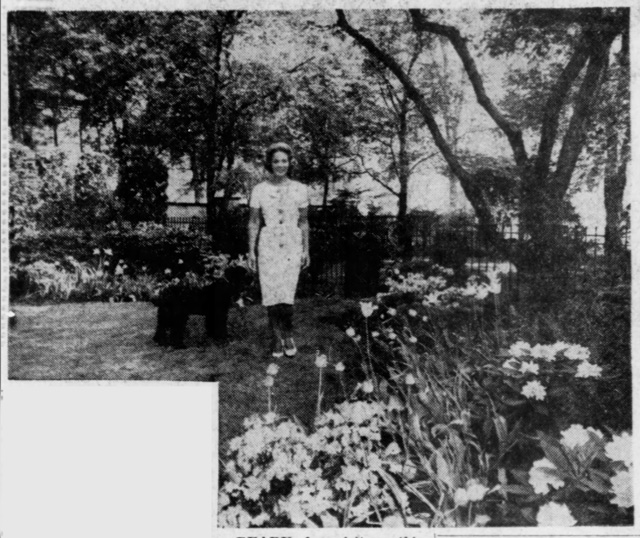
In 1963, with the event still going strong, the map below shows the location of the nine gardens in Grosse Pointe that were on the tour, including the Herman Otto Garden at 741 Trombley. It was described as “a new garden, featuring statuary brought from the Castle of Nymphenburg in the Bavarian Alps. Railroad ties were used to support high embankments of soil which held wisteria trees and annuals. There was also a large stone terrace”. Source and image: Detroit Free Press (June, 1963).

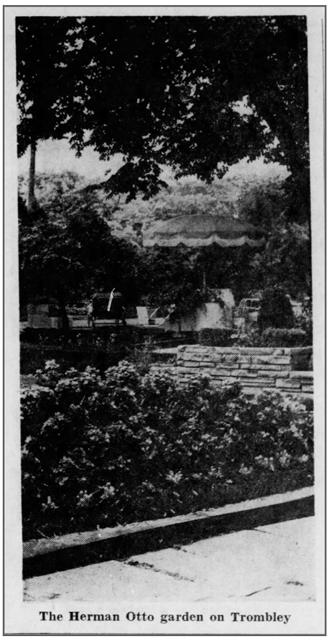
By 1967, the number of gardens in Grosse Pointe on the tour had begun to recede. Visitors were once again able to tour the gardens at the War Memorial (a regular stop on the Pilgrimage tour over the years), and that year the Christ Church Memorial Garden was part of the event. One of the residences on display was 236 Cloverly, the home of Mrs. John N. Lord. The garden featured “fashion roses bordering the swimming pool on the upper level, while Japanese Iris flourished in a hollow.” Source and image: Detroit Free Press (June, 1967).
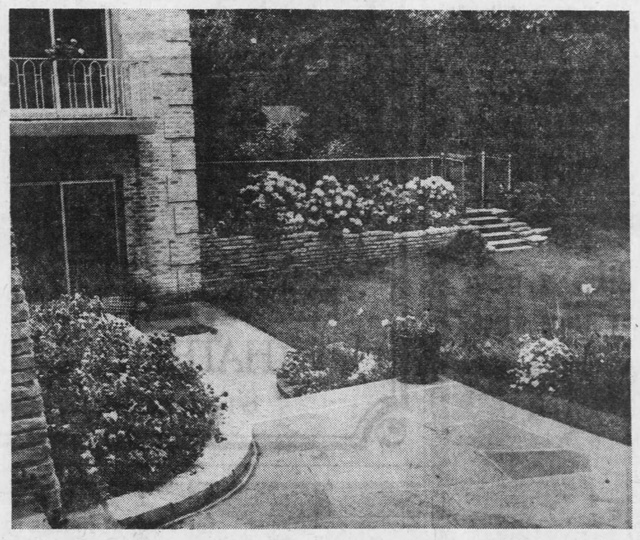
It appears the Detroit Garden Center’s Garden Pilgrimage Tour came to an end in the late 1960’s We have been unable to find any record of the event post 1970. Over the years the tour allowed hundreds of people to visit some superb gardens that were not only found in Grosse Pointe, but across Metro Detroit.
Today a smaller tour in Grosse Pointe still exists, held by the Grosse Pointe Garden Center. This year, the 32nd annual tour took place from 21-22 June and featured seven special gardens. It continues to remain an extremely popular event.
*Photos courtesy of the Higbie Maxon Agney archives unless stated.
** Research, information, and data sources are deemed reliable, but accuracy cannot be fully guaranteed.
Written by Katie Doelle
Copyright © 2024 Higbie Maxon Agney & Katie Doelle

